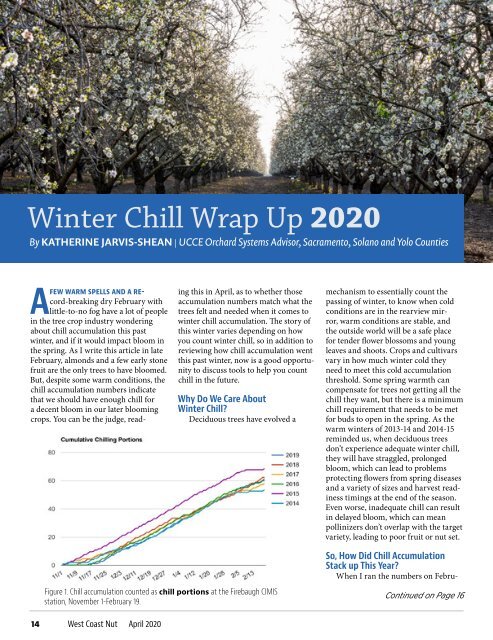Create successful ePaper yourself
Turn your PDF publications into a flip-book with our unique Google optimized e-Paper software.
Winter Chill Wrap Up <strong>2020</strong><br />
By KATHERINE JARVIS-SHEAN | UCCE Orchard Systems Advisor, Sacramento, Solano and Yolo Counties<br />
A<br />
few warm spells and a record-breaking<br />
dry February with<br />
little-to-no fog have a lot of people<br />
in the tree crop industry wondering<br />
about chill accumulation this past<br />
winter, and if it would impact bloom in<br />
the spring. As I write this article in late<br />
February, almonds and a few early stone<br />
fruit are the only trees to have bloomed.<br />
But, despite some warm conditions, the<br />
chill accumulation numbers indicate<br />
that we should have enough chill for<br />
a decent bloom in our later blooming<br />
crops. You can be the judge, reading<br />
this in <strong>April</strong>, as to whether those<br />
accumulation numbers match what the<br />
trees felt and needed when it comes to<br />
winter chill accumulation. The story of<br />
this winter varies depending on how<br />
you count winter chill, so in addition to<br />
reviewing how chill accumulation went<br />
this past winter, now is a good opportunity<br />
to discuss tools to help you count<br />
chill in the future.<br />
Why Do We Care About<br />
Winter Chill?<br />
Deciduous trees have evolved a<br />
mechanism to essentially count the<br />
passing of winter, to know when cold<br />
conditions are in the rearview mirror,<br />
warm conditions are stable, and<br />
the outside world will be a safe place<br />
for tender flower blossoms and young<br />
leaves and shoots. Crops and cultivars<br />
vary in how much winter cold they<br />
need to meet this cold accumulation<br />
threshold. Some spring warmth can<br />
compensate for trees not getting all the<br />
chill they want, but there is a minimum<br />
chill requirement that needs to be met<br />
for buds to open in the spring. As the<br />
warm winters of 2013-14 and 2014-15<br />
reminded us, when deciduous trees<br />
don’t experience adequate winter chill,<br />
they will have straggled, prolonged<br />
bloom, which can lead to problems<br />
protecting flowers from spring diseases<br />
and a variety of sizes and harvest readiness<br />
timings at the end of the season.<br />
Even worse, inadequate chill can result<br />
in delayed bloom, which can mean<br />
pollinizers don’t overlap with the target<br />
variety, leading to poor fruit or nut set.<br />
So, How Did Chill Accumulation<br />
Stack up This Year?<br />
When I ran the numbers on Febru-<br />
Figure 1. Chill accumulation counted as chill portions at the Firebaugh CIMIS<br />
station, November 1-February 19.<br />
Continued on Page 16<br />
14 West Coast Nut <strong>April</strong> <strong>2020</strong>


















